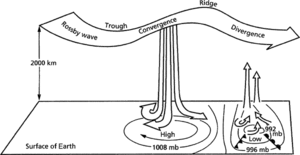Named after the Swedish-American meteorologist Carl-Gustav Rossby (1898–1957), Rossby waves are equatorward troughs and poleward ridges forming long waves in the circumpolar flow of the upper air, particularly in the mid and upper troposphere, with a typical wavelength of around 2000 km. Three or four waves usually occur in the circumpolar westerly wind flow over mid latitudes. They may remain stationary (as standing waves) when wind speed and wavelength have a given relationship. The waves may be initiated by lower winds over mountain barriers, e.g. the Rocky Mountains, or by heating over warm oceans in winter or over land in summer. They are then amplified by vorticity (due to the Earth’s rotation) in anticyclonic curvature (in ridges) and in cyclonic curvature (in troughs). Characteristic positions for the main troughs in the upper westerlies over the northern hemisphere are about 70° W and 150° E. The Rossby waves influence the formation of surface depressions which tend to develop on a frontal wave ahead of an upper trough. Rossby waves also occur in the oceans.
Long ridges and troughs in the westerly movements of the upper air, with a wavelength of around 2 000 km, discovered by C. J. Rossby in 1939. Four to six waves girdle the Northern Hemisphere at any one time. Some are a response to relief barriers, like those east of the Rockies, and east of the Himalayas (O’Kane and Frederiksen (2005) ANZIAM J. 46 (E), C704–C718).
Rossby waves are thought to be a reaction to the unequal heating of the Earth’s surface, and are intimately connected with the formation of cyclones (Li et al. (2006) J. Atmos. Scis 63, 5), anticyclones (Chen and Newman (1998) J. Climate 11, 10), and mid-latitude depressions. As air in the middle latitudes of the Northern Hemisphere travels west–east into a trough, it slows down, and piles up, causing convergence just ahead of the ridge which follows. Convergence in the upper air causes a downflow to the ground, creating high pressure systems at ground level, below and just ahead of troughs in the Rossby waves. As air leaves the trough, and its passage straightens out, air speeds pick up, and the air moves very fast as it swings round the outer arc of the ridge. Air then diverges just ahead of the next trough. Divergence in the upper air causes low pressure systems at ground level below and just ahead of ridges.
At times, the waves are few, and shallow; a pattern known as a high zonal index. In other cases, the flow becomes markedly meridional; a pattern known as a low zonal index. Upon occasion, the waves break down into a series of cells (Rossby wave-breaking; see blocking). Woollings and Hoskins (2008) J. Atmos. Scis 65, 2 suggest that the low-frequency variability of the North Atlantic Oscillation results from variations in upper-level Rossby wave-breaking events.

Rossby wave
- glacial deposition
- glacial diffluence
- glacial diversion
- glacial drainage channel
- glacial erosion
- glacial ethanoic acid
- glacial horn
- glacial lake outburst flood
- glacial limit
- glacial meltwater
- glacial morphoclimatic zone
- glacial period
- glacial plucking
- glacial stairway
- glacial surge
- glacial theory
- glacial transfluence
- glacial trough
- glacial–interglacial cycle
- glaciaquatic
- glaciated rock knob
- glaciation
- glacier
- glacier budget
- glacier creep